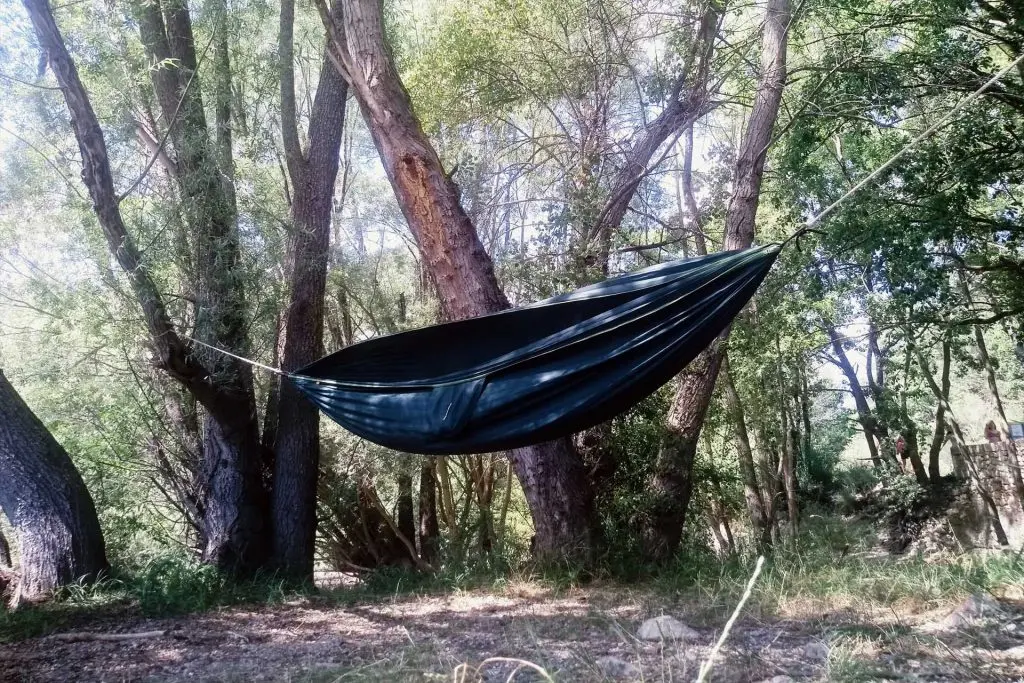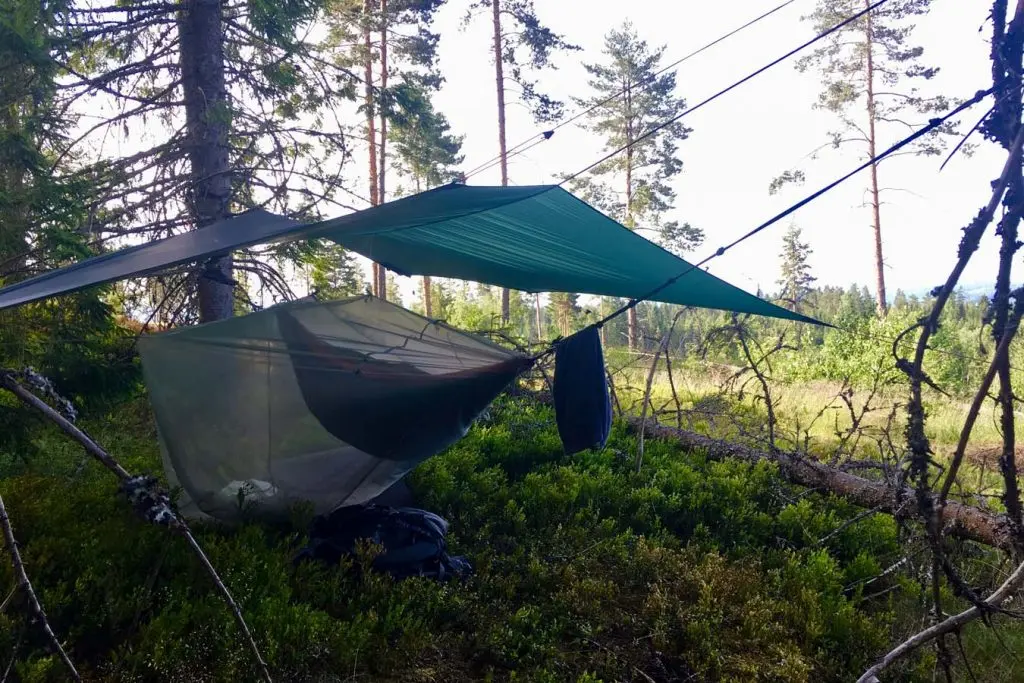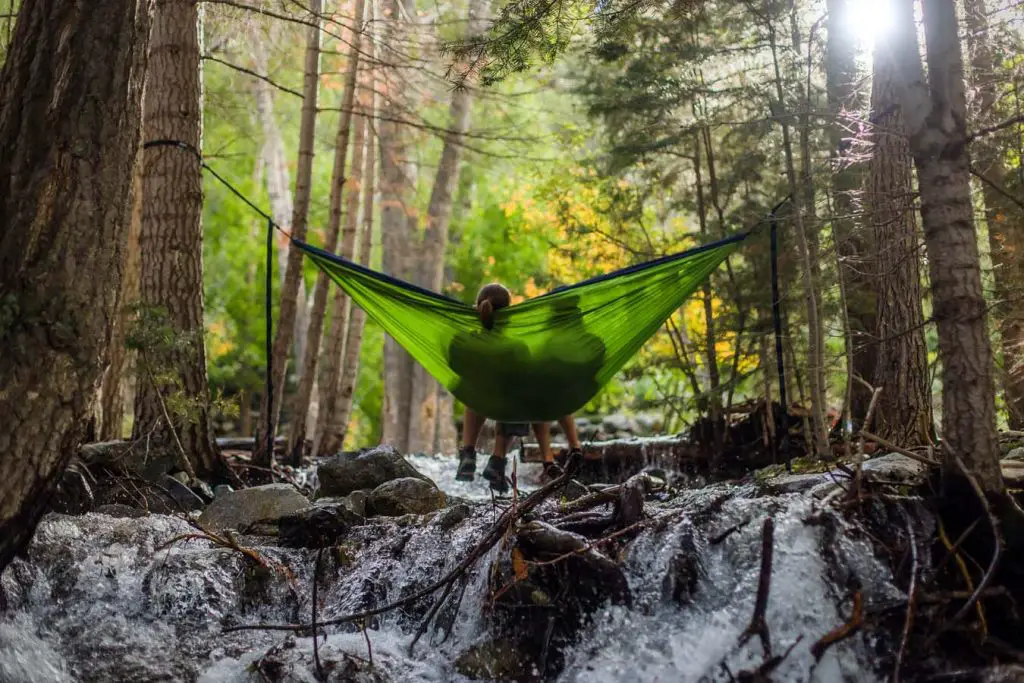With so many people taking more camping trips this year, it’s important to remember that the summer heat isn’t something to by-pass or simply ignore. Without proper care and preparation, hot weather can cause severe injury and even be fatal.
So before you set out on your next outdoor adventure, be sure to know how to hammock camp in hot weather and keep your setup cool.
Tips and Tricks to Staying Cool While Hammock Camping in Hot Weather
Unlike hammock camping when it’s cold, there are no obvious solutions to keeping you cool when it comes to hammock camping in hot weather. There are only so many layers you can shed without going full nudist at your campsite. At least in cold weather you can bundle up with top quilts, underquilts, and hefty-duty covers! But in hot weather, there’s not an easy solution.
Instead, you can try to combine the below suggested tips in effort to stay cool and comfortable as much as feasibly possible.
1. Ditch the warm layers unless temperatures drop below 70 degrees F
One of the best ways to stay cool while hammock camping in hot weather is to simply avoid using any hammock pads, thick sleeping bags, or warm underquilts. Most people will start to feel chilly when nightly temperatures drop below 70-75 degrees.
In case it does get cooler at night, using a hammock liner or soft blanket will do the trick of preventing CBS – cold butt syndrome – from the wind’s updraft. In truly hot weather, though, CBS shouldn’t happen.
However, even if you expect hot temperatures throughout the night, it’s best to pack a thin blanket or quilt that you can quickly grab just in case.
2. Optimize for air flow
Another way to stay cooler in a hammock in hot weather is to ensure you have maximum ventilation. Obviously you can’t control the breeze, but you can control how much air reaches you inside your hammock.
Some ways to do this is to use a bug net with larger holes to allow air to pass through more easily (you might want to get the net treated, though). Raising your hammock’s protective tarp or rainfly higher will also help in allowing more air through. Just make sure to not raise it too high that you’re no longer fully covered in case of unexpected rain.
3. Use a battery or solar-powered fan
If you’re hammock camping in hot weather in places such as Florida or Texas, where high temps are expected during the summer, then you could supplement your gear with a portable fan. A mini fan can really help cool you down when there is no natural breeze to do it for you. You could even set up the fan to where it suspends from your hammock line or rain fly and have it point directly at you. Taking a mini fan with you is by no means the best solution, but they are useful and are easy to tuck into your backpack.
4. Make sure your hammock fabric is lightweight and breathable
Hammock camping during hot weather in the summer months looks a lot different than in the cold, snowy months of winter. The climates jump from one spectrum to the other. It’s only appropriate your hammock gear should adapt too!
Using a season-appropriate hammock is the best way to help regulate the temperature inside your hammock – so you’re neither too hot nor too cold. To beat the summer heat, make sure your hammock is made with lightweight, breathable fabric (nylon or polyester is best).
Equipment Upgrades to Improve Your Summer Hammock Setup
Summer is the time for grilling, making (safe) campfires, roasting marshmallows, and cozying up under the stars with your adventure buddy or pup. But with summer also comes pesky mosquitoes, humidity, frequent bug bites, and not to mention having to find appropriate locations to use the bathroom (especially when wild camping).
But with a few extra upgrades to your hammock gear, you could make the most of summer while keeping annoyances and inconveniences at bay.
Portable camp grill
A great way to improve your summer hammock experience is to invest in a portable camping grill. Throw on a few brats, corn cobs, and veggie kebabs and voila! If you’re backpacking to your hammock campsite, of course you will need a collapsible or at least foldable grill.
But if you are heading out on a road trip adventure, you can maybe spare extra space to accommodate a grill with heavier poundage and durability.
Hefty-duty moving blanket
Ideal for dogs, or just about whatever reason you need, a cheap ($10) Harbor Freight moving blanket is a great accessory to take on your hammock camping trip. Not only does it expel fluids, dirt, and other debris, but it can also double as a convenient picnic blanket that doesn’t rip, tear, or trap twigs and leaves from the ground.
Anti-itch bug repellent
Most, if not all hikers, won’t forget to pack the bug spray that deters biters and blood suckers from coming near. But rarely do people remember to pack anti-itch cream in case of an unplanned bite. Depending on who you are, mosquito bites can be unbearable.
If you’re the type to scratch at bites for hours to no avail, then you might want to make room for anti-itch cream or a handy little suction tool known as the Bug Bite Thing which actually relieves itching by sucking out the saliva from an insect bite!
Portable potty or bags
Camping is all fun and games until your stomach tells you it’s time to use the bathroom. If you’re heading out on a family hammock camping trip or just want to make it more convenient for yourself “to go” out in nature, consider taking along a portable camping potty. This won’t be ideal if you’re backpacking to your destination, in which case you should carry sustainable bags.
As more and more people head out on camping trips, parks are having to double-down on how to appropriately relieve yourself outdoors.
Remember, improper disposal of human waste can be extremely pollutive, spread disease, and attract wildlife. Let’s all work together to keep our parks and public BLM lands poop-free.
FAQS
Do hammocks get hot in the summer?
Hammocks, by nature, work to keep you cool by allowing air flow to circulate both on top of and below you. So while it can be hot outside, hammocks themselves will rarely become hot (unless they’re in direct sun during the day).
How do you keep a hammock cool?
The number one factor that will determine whether your hammock stays cool or not is the location. The location matters a great deal. Are you exposed to wind? If not, try to set up your hammock on the top of a ridge, without barriers around, so that air can circulate naturally.
If you’re down low in a valley, try to set up camp next to a source of water. Rivers, streams, and lakes will have cool air flowing off the top and this can help to keep you much cooler in your hammock even during hot weather.
Do you need an Underquilt in the summer?
Despite the thermometer announcing hot temperatures, it is a wise decision to pack an underquilt even for hammock camping in the summer. If you don’t, you could be exposing yourself to cooler-than-expected drafts which seep in underneath your hammock.
If you’re thinking a sleeping bag should do the trick, you might want to reconsider. Sleeping bags compress underneath your weight, whereas underquilts do not (as they tuck below the hammock, not inside it). Underquilts are generally a must-have accessorize to any hammock camping trip. If you don’t end up using it, no biggie! They come as light as 2 lbs or less so it’s not like you are sacrificing too much weight on it.
Top quilt in hot weather?
Underquilts might be a good idea for summer camp trips, but top quilts? Not so much. A top quilt works to insulate and keep warmth in, so you won’t need a top quilt when hammock camping in hot weather.
In the case where you just want something on top like a security blanket, a lightweight cotton sheet will work and is easy to kick off in the night.
What is the best material for a hammock in hot weather?
The best material for a hammock in hot weather will be the parachute nylon material or a combination of cotton and polyester.
Nylon hammocks are all at once breathable, durable, and moisture-wicking. Cotton/polyester hammocks are also a good option, but are better suited for backyard hammocks or patios rather than frequent hammock camping use.
Summary
There is a lot of information about what to do in cold weather, and little about how to hammock camp in hot weather.
In this guide, we discussed everything there is to know about staying cool when hammock camping during the summer. From choosing the best location to supplementing your hammock gear with extra tools and accessories, there are a few ways to optimize air flow to ensure a comfortable night’s sleep in your hammock even during hot weather!
Have you ever camped in a hammock in really hot weather before? What tricks did you use to stay cool?
Related guides
How To Find The Best Hammock Straps
35 Hammock Tips For First-Time Campers
How To Hang Your Hammock Between Two Trees




